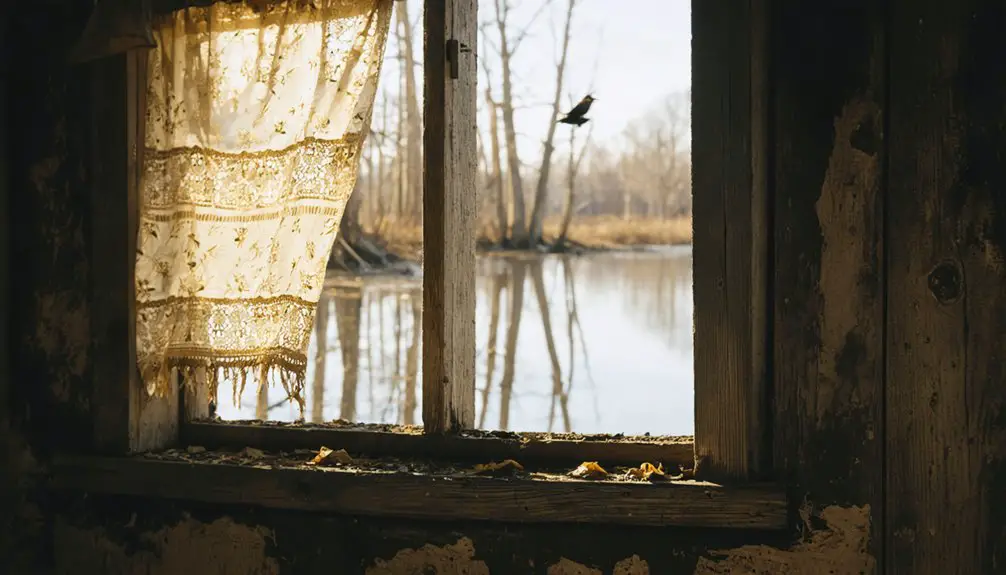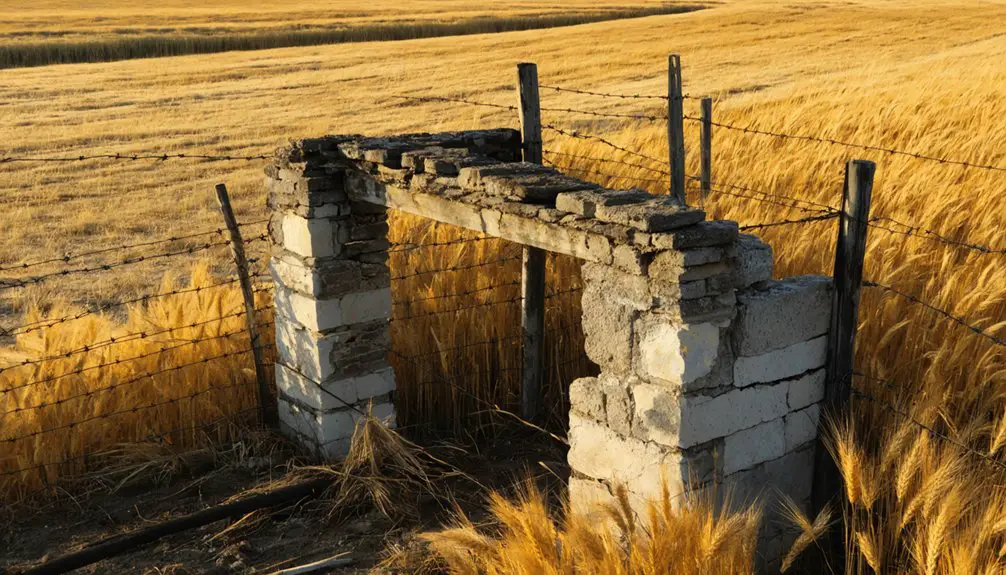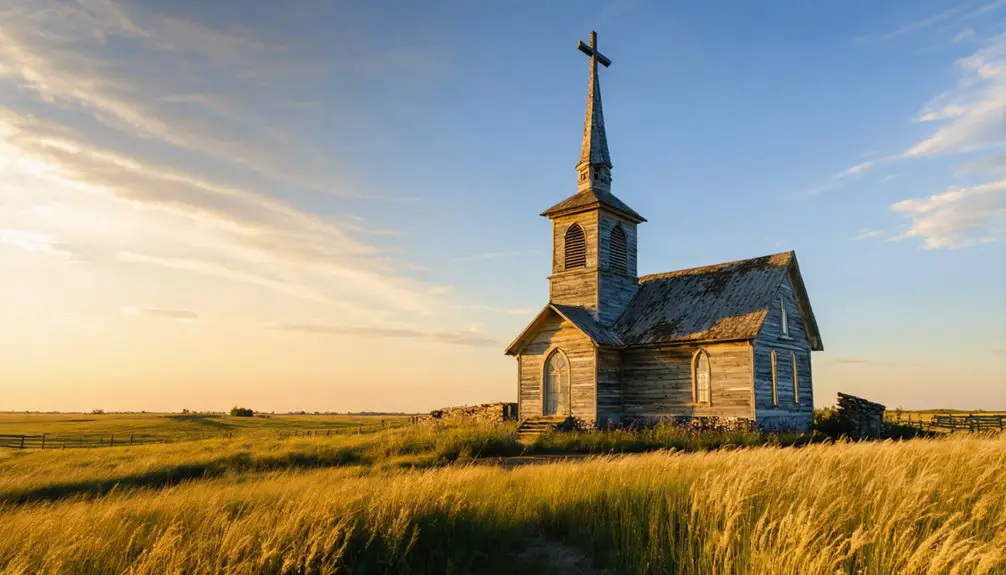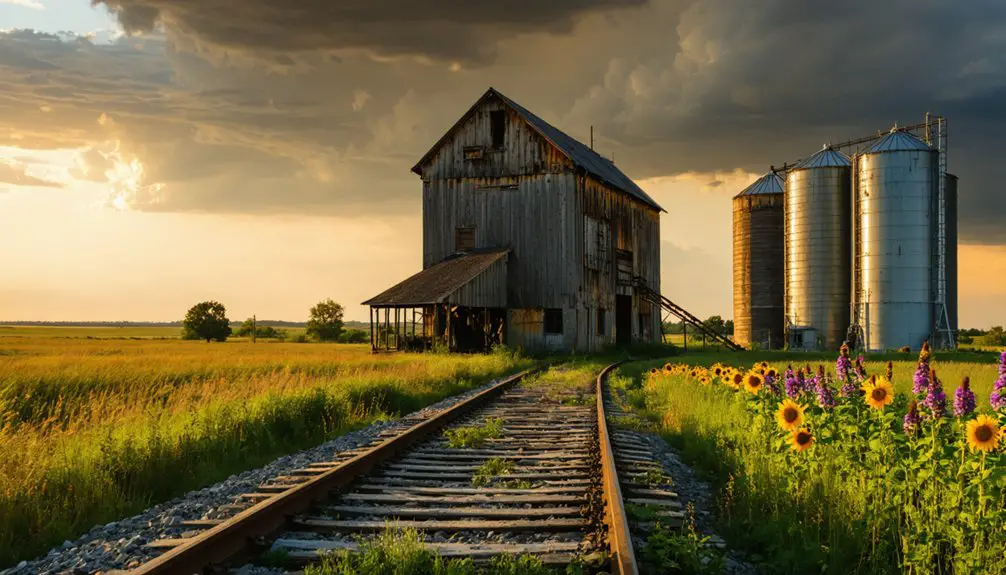You’ll find Lake Sibley’s ghost town in Cloud County, Kansas, where Swedish, Norwegian, and English settlers established a frontier community in 1869. Despite early promise, the settlement faced devastating Native American raids, including the death of Ezra Adkins. After losing the county seat election to Concordia in 1870, coupled with the mysterious drowning of the reclusive Poore sisters in 1890, Sibley’s decline became inevitable. The limestone monuments and old schoolhouse still hold countless untold stories.
Key Takeaways
- Lake Sibley, established in 1869 in Cloud County, Kansas, declined after losing the county seat election to Concordia in 1870.
- The settlement faced early challenges including Native American conflicts, with a notable raid in May 1869 killing settler Ezra Adkins.
- The tragic drowning of reclusive educators Adell and Hannie Poore in 1890 marked a somber chapter in Lake Sibley’s history.
- Agricultural development stalled due to water scarcity when Lake Sibley dried up, significantly impacting farming potential in the area.
- Only limestone monuments and an old schoolhouse remain as physical evidence of this once-promising Kansas frontier settlement.
The Birth of a Pioneering Settlement
While early settlers began homesteading the Lake Sibley area around 1860, the town of Sibley wasn’t formally established until 1869 in Cloud County, Kansas.
You’ll find that these initial settlers, primarily from Sweden, Norway, and England, embodied true pioneer values as they carved out their existence on the frontier.
The community’s foundation was marked by both promise and peril. You’d have witnessed neighbors banding together, displaying remarkable community resilience in the face of Indian raids, including the tragic death of Ezra Adkins in 1869. Much like the devastating Sibley fire of 1904, these early challenges tested the determination of frontier communities.
Homesteaders and Early Community Life
As the 1860s unfolded, Lake Sibley’s early homesteaders established a diverse community that reflected America’s immigrant tapestry. You’d find settlers from Kentucky, Pennsylvania, and Poland breaking land, digging wells, and building cabins across 160-acre parcels.
Community resilience emerged through shared struggles, as families banded together against Indian raids and supported newcomers through cultural integration. The settlers had to travel sixty miles to a post-office and faced considerable hardship accessing basic services. The picturesque area offered clear fishing waters that helped sustain the growing population.
The settlement’s backbone included innovative solutions like the Bohemian rock house on Mill Creek, which sheltered multiple families. You’ll recognize the determination in their daily lives – from farming and raising livestock to organizing defensive measures when threatened.
Despite challenges like isolation and disease, including the tragic story of the Poore sisters, these pioneers forged lasting bonds through their churches, schools, and mutual support systems.
The Fatal County Seat Election
The 1870 county seat election between Sibley and Concordia marked a defining moment that would seal Lake Sibley’s fate.
You’ll find the election implications were swift and devastating – as Concordia emerged victorious, Sibley’s dreams of becoming a thriving administrative center crumbled. The settlement dynamics of post-Civil War Kansas meant that county seat status could make or break a town’s future, and Sibley learned this lesson the hard way. Located five miles northwest of Concordia, the town’s proximity to its rival added to the bitter defeat.
What you’re seeing in this pivotal election reflects the fierce competition among early Kansas settlements, where political decisions could transform promising towns into abandoned dreams. Much like the Sibley Fire disaster of 1904 in New York, this event marked a turning point that devastated the local community.
After losing the vote, Sibley’s development halted abruptly. While Concordia flourished as Cloud County’s hub, Sibley faded into obscurity, eventually becoming the ghost town you’d find today.
Native American Conflicts and Legacy
You’ll find evidence of Lake Sibley’s darkest chapter in the May 1869 raids, when Native American bands attacked settlements along the Republican River near the town.
The most notable incident involved the death of Ezra Adkins, whose grave became a lasting memorial to the conflicts between settlers and indigenous peoples in the region. Settlers like Benjamin White were attacked during a particularly hot and dry summer in 1868, setting the stage for continued conflicts.
Local militias formed in response to these attacks, establishing safe houses and fortified positions that would shape the development of frontier communities for years to come. A massive battalion of 311 troops was mustered by the Adjutant-General to help protect the frontier settlements in the area.
Last Indian Raid Events
During the early 1700s, violent clashes erupted between Kanza raiders and Shawnee groups under Chief Rattlesnake’s leadership, marking significant conflicts that would echo through later decades of Native American resistance in Kansas Territory.
These tribal rivalries set the stage for increasingly tense relations as white settlers pushed westward.
You’ll find that military campaigns intensified in the 1860s and 1870s, with General Patrick Conner’s forces targeting Native American males over age twelve to suppress raids.
The Colorado War and Sand Creek Massacre of 1864 further inflamed hostilities, leading to sustained resistance from groups like the Cheyenne Dog Soldiers.
The Sieur de Bourgmont expedition in 1724 attempted to establish peace between warring tribes, though tensions persisted.
In 1864, conflict between Indians and frontier settlers escalated dramatically across Kansas and Nebraska territories.
Custer’s 1868 campaign into the Washita River valley represented one of the final major offensives, effectively ending organized Native American resistance in the Kansas region.
Commemorating Ezra Adkins’s Story
Among the most poignant stories of Native American conflicts in Cloud County stands the tragic tale of Ezra Adkins, an 11-year-old settler boy killed by Native Americans on June 2, 1869, south of what’s now the Omar Dutton Farm.
Ezra’s legacy lives on through several historical markers that remind you of the complex relationship between settlers and Native Americans during America’s westward expansion:
- A memorial stone near the Sibley town site marks his memory as the last white settler killed by Indians in Cloud County.
- His burial site remains on his family’s original homestead, where his father Homer settled in 1868.
- The story serves as an essential piece of Cloud County’s frontier history, preserved through local documentation.
According to accounts documented in Kanhistique 1982, the young Adkins boy’s death marked a significant turning point in local settler-Native American relations. This commemoration helps maintain the historical significance of Sibley’s past while educating future generations about settlement challenges.
Tales of the Poore Sisters

You’ll discover that Adell and Hannie Poore, retired schoolteachers who settled in Sibley in 1889, established themselves as particularly reclusive figures who strictly limited their social interactions, particularly with men.
Their intensifying fear of tuberculosis, a deadly disease of the era, consumed their daily thoughts and eventually led to their isolation from the broader community.
In a final act that shocked the townspeople, the sisters left their wills in a cracker box, walked hand-in-hand into Lake Sibley, and drowned themselves in March 1890, forever becoming known as the “Ladies of the Lake.”
Local Teachers’ Early Lives
In late 19th century Kansas, two remarkable educators, Adell and Hannie Poore, settled near Lake Sibley around 1889, where they’d become integral figures in the region’s early educational development.
Despite the educational challenges of frontier life, these independent women tackled the demanding task of teaching in multi-age classrooms with limited resources.
Their community contributions were significant, though they maintained a particularly private lifestyle:
- As among the few educated residents, they helped establish the area’s educational foundation
- Their teaching methods adapted to serve diverse student needs in the rural setting
- They balanced professional dedication with a deliberately reclusive personal life
You’ll find their impact on Lake Sibley’s development especially remarkable, as they represented the determination of early frontier educators while maintaining their fierce independence.
Their Reclusive Nature
While Adell and Hannie Poore earned respect as educators in Lake Sibley, their private lives painted a stark contrast to their public roles. The sisters’ social withdrawal became increasingly noticeable after they settled in Sibley in 1889.
You’d have found them deliberately avoiding men and limiting their interactions with others, though the community perception remained largely sympathetic.
Their isolation intensified as fears of tuberculosis, a deadly disease of the era, gripped their minds. Despite their reclusive tendencies, you’d be surprised to learn that locals still held them in high regard.
The sisters would eventually become known as the “Ladies of the Lake,” a nickname that captured both their mysterious nature and their tragic end in Lake Sibley’s waters.
Final Tragic Decision
Fear of tuberculosis ultimately drove Adell and Hannie Poore to make their final, devastating choice in March 1890.
The sisters’ isolation had shaped their lives in Sibley, and now it would mark their tragic legacy. Before walking hand-in-hand into Lake Sibley’s waters, they carefully prepared their last affairs:
- Left their wills in an empty cracker box
- Chose drowning as their method of death
- Made their final journey together to the lake’s edge
You’ll find their story woven into the fabric of Sibley’s decline, remembered by locals as the “Ladies of the Lake.”
Their deaths reflect the harsh realities faced by rural Americans of their era – the limited medical care, the lack of mental health support, and the crushing weight of terminal illness that drove two respected schoolteachers to their devastating end.
Agricultural Heritage and Land Use

During the 1860s, Lake Sibley’s agricultural heritage took root as homesteaders from Sweden, Norway, and England established farms across the frontier landscape.
You’d find these pioneering families practicing sustainable farming through mixed subsistence, combining crop cultivation on 160-acre parcels with hunting, fishing, and trapping to survive the harsh terrain.
Their community resilience showed in how they adapted to prairie conditions, tapping box-elder trees for syrup and crafting vinegar from melon juice.
Each family worked intensively, managing roughly 100 acres under plow while raising livestock.
Children contributed by trapping, while women played essential roles in both homestead operations and community building.
Despite challenges from Native American raids and limited infrastructure, these settlers maintained strong social bonds through schools and community gatherings, establishing lasting agricultural traditions.
Remaining Landmarks and Memorials
As Lake Sibley faded into history, only a handful of landmarks remained to tell its story. The cultural significance of these historical artifacts serves as a window into the town’s pioneering spirit and tragic past.
You’ll find poignant reminders of early settler life through:
- The Ezra Adkins Memorial stone, marking where Indians killed him in 1869
- Weathered remains of the schoolhouse, standing as the last major structure
- Lake Sibley itself, surrounded by native prairies and creek systems
The site also preserves the memory of the reclusive Poore sisters, Adell and Hannie, who drowned in the lake’s waters.
While most physical structures have vanished, these remaining landmarks continue to anchor the community’s connection to its frontier heritage and the determined settlers who shaped it.
Northern European Immigrant Influence

Northern European immigrants fundamentally shaped Lake Sibley’s development when Swedish, Norwegian, and English homesteaders began settling the area around 1860.
These settlers brought their cultural traditions and established tight-knit communities centered around Lutheran churches and shared agricultural practices.
Lutheran faith and farming wisdom bound these newcomers together, weaving Old World traditions into the fabric of their frontier communities.
You’ll find that their educational values left an enduring mark on the region, as they prioritized literacy and learning by establishing local schoolhouses that served both educational and community gathering purposes.
Swedish and Norwegian teachers helped preserve their heritage while adapting to life on the Kansas plains. Their farming techniques, specifically tailored to local conditions, formed the economic foundation of early Sibley.
Through cooperative networks and shared knowledge, these immigrants created a resilient community that maintained its Scandinavian character while building a new American identity.
From Thriving Township to Abandoned Dreams
While Lake Sibley initially showed promise as a frontier settlement in 1869, the township’s path toward prosperity faced immediate challenges that would ultimately lead to its downfall.
Despite the pioneering spirit of early settlers, three devastating blows crushed the community’s dreams:
- Violent conflicts with Native Americans, including the tragic death of Ezra Adkins, created an atmosphere of uncertainty and fear.
- The pivotal loss of the county seat election to Concordia in 1870 diverted essential economic development and railroad connections.
- The eventual drying of Lake Sibley eliminated a significant water resource, making farming unsustainable.
Though the community’s resilience showed through determined efforts to maintain their homes and livelihoods, these compounding setbacks proved insurmountable.
Today, only limestone monuments and the old schoolhouse remain as silent witnesses to Sibley’s abandoned dreams.
Notable Figures Who Shaped Sibley’s Story
Several remarkable individuals left lasting imprints on Lake Sibley’s brief but eventful history. Among the local legends, you’ll find Ezra Adkins, whose tragic death in 1869 marked the last Indian killing in Cloud County. His parents, Homer and Hannah Adkins, became central figures in preserving this pivotal moment through historical accounts.
The Nelson family’s experience during an Indian raid added another layer to Sibley’s frontier narrative. Making cultural contributions beyond the town’s borders, economist May Louise Cowles gained recognition for her groundbreaking studies on clothing consumption.
The poignant story of the Poore sisters, Adell and Hannie, known as the “Ladies of the Lake,” reflects the harsh realities faced by early settlers as they succumbed to their fears of tuberculosis.
Frequently Asked Questions
What Is the Current Population Living Within Lake Sibley’s Former Boundaries?
You’ll find zero permanent residents within Lake Sibley’s former boundaries today. Current demographics reflect the ghost town history – it’s now privately owned farmland where pioneers once dreamed of prosperity.
Are There Any Surviving Photographs of Lake Sibley During Its Peak?
You won’t find any confirmed surviving photographs from Lake Sibley’s peak era in ghost town archives or historical photography collections. No images have been publicly documented or cataloged in accessible records.
When Was the Last Standing Building in Lake Sibley Demolished?
You won’t find exact demolition timeline records, but historical documents suggest the last structures disappeared gradually as the land converted to farmland, likely before modern recordkeeping began tracking such changes.
Can Visitors Access the Lake Sibley Site Today for Historical Tourism?
Want to explore historical significance firsthand? You can’t freely access Lake Sibley’s site since it’s private farmland. Visitor guidelines require landowner permission, though you can view the schoolhouse and monument from public roads.
What Happened to the Town’s Official Records and Documents?
You won’t find Sibley’s official records today – they’re completely missing from archives. The town’s abandonment and private land acquisition led to their loss, with no historical preservation efforts saving them.
References
- https://lostkansas.ccrsdigitalprojects.com/sites/lostkansas/files/private_static/2022-12/LT_CD_Sibley_Woellhof.pdf
- https://en.wikipedia.org/wiki/Sibley
- https://kids.kiddle.co/Sibley
- https://legendsofkansas.com/everyplace-in-kansas-s/
- https://krex.k-state.edu/items/b686a787-b9b9-41cc-a027-73ff64d9930c
- https://bladeempire.com/stories/uncovering-the-history-of-sibley
- https://www.wikiwand.com/en/articles/Sibley
- https://www.kancoll.org/books/cutler/cloud/cloud-co-p1.html
- http://www.lovewellhistory.com/blog/lake-at-the-edge-of-the.html
- https://fhsuguides.fhsu.edu/kansasheritage/republiccounty



